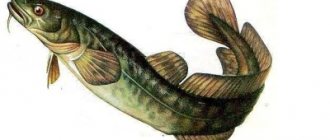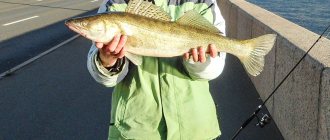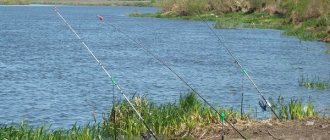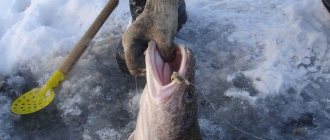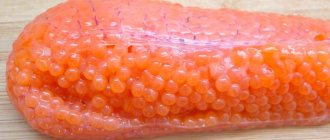Burbot 03/14/2015 05:23
Every year, St. Petersburg fishermen experience the “delights” of the off-season. Summer has passed, winter has not yet arrived. In a word - no bite. Oh, it’s autumn – it’s raining and windy outside. It would seem, what kind of fishing can there be at this time of year? Most fishermen think so and spend their weekends watching TV.
But not everything is so hopeless. Even in late autumn you can actively fish in the reservoirs of the Leningrad region. What can you catch, you ask? There is a fish that actively feeds in inclement weather - this is burbot. It is caught all autumn, winter, spring and is a “lifesaver” in the off-season.
The time when burbot goes to spawn
The largest populations of this freshwater representative of cod are found in the northern latitudes of our country. Here this fish lives in almost all reservoirs. Large individuals thrive in fast, cold rivers. Burbot spawning time occurs around mid-winter, usually in January. For example, burbot spawning in the Urals takes place in the dead of winter. It must be said that in this region it is during this period that fishermen catch valuable commercial fish by drilling holes in the middle of the river.
Spawning of burbot in Siberia, for example, can begin in the second half of December. Often in reservoirs in the central part of our country it shifts to February. The timing of burbot spawning depends primarily on the region where the fish lives, on a specific lake or river.
Burbot in the Leningrad region
Burbot belongs to the cod family. Unlike its fellows, it lives and reproduces not in the sea, but in fresh waters. This fish is very sensitive to water quality, so it loves only clean and flowing waters. As a rule, burbot lives in rivers and lakes with a sandy or rocky bottom.
Peak feeding activity occurs in late autumn. At this time, he gets out of the pits and approaches the shores in search of food. Burbot is a predator. Young burbots feed on sculpins, lamprey larvae and other invertebrates. When the body length reaches 20 cm, they completely switch to small fish: ruffe, gudgeon, smelt, smelt. Adults hunt crayfish and frogs. A favorite delicacy is caviar of valuable fish species: salmon, whitefish, grayling, trout.
Spawning of burbot occurs in the middle of winter - January, February. Such a late spawning suggests that this fish came to us from the north. Ichthyologists still cannot understand what an individual of the cod family does in freshwater bodies. Burbot lays its eggs in shallow water. A large female can lay up to 3 million eggs. In the Leningrad region, burbot grows up to 12 kg.
The largest specimen was caught before the revolution in 1910. His weight was 16kg. Burbot is nocturnal. He sleeps during the day and goes out hunting when darkness comes. In the spring, when the water begins to warm up, burbots go deeper. They hide under stones, fallen trees, washed-out banks and other secluded places. In hot weather, it hibernates and spends the entire summer in this state.
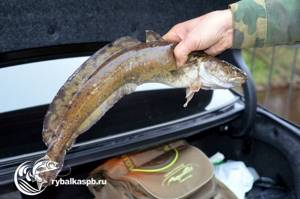
(photo: Vladimir Gavrilov - https://vk.com/id7523886)
Ban on catching burbot during spawning
There is just one “but”. In many parts of Russia there is a ban on catching burbot during its spawning season. The timing of this ban is different for each region - for example, in the Moscow region, catching burbot from December 15 to January 15 will be considered poaching. The exact dates of the ban in your area can be checked with regional fishing organizations. As a rule, they last no more than a month, so fishermen will also have time to catch burbot during spawning.
Where's the fish?
Here we come to the main question - where do burbot spawn? As a rule, burbot are plentiful at the mouths of rivers, from where they ALWAYS go against the current to spawn. When burbot goes to spawn, it sometimes covers fantastic distances - for example, it climbs 400 kilometers along the Irtysh River and finishes spawning in February, that is, along with the “trip”, spawning turns out to be very long in time. He walks quite slowly, not forgetting to feed on his main food - small fish and look into possible places of their winter resting place.
Where to catch burbot?
Burbot is ubiquitous in the reservoirs of the Leningrad region. The only exceptions are stagnant swampy lakes inhabited by crucian carp. The spotted predator can be found in the Neva, which flows into the Gulf of Finland. It is also found in the bay itself, in places with fresh water.
There are a lot of burbot in Onega, Pskov-Chudskoye and Ladoga lakes. In Lake Ilmen, burbot is also often caught in catches, like roach or perch. In search of the desired trophy, fishermen can go to the following rivers: Volkhov, Pasha, Svir, Tigoda, Chernaya Rechka, Morye, Tosna, Ravan, Luga, Sestra. They also successfully catch burbot in the Novoloadozhsky Canal and on the Neva near Shlisselburg. In principle, any river with a small current is suitable for fishing. The main thing is that the river has both deep holes and shallow spits.
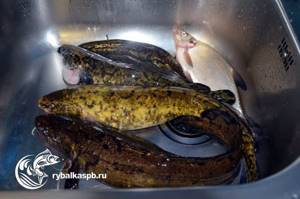
Burbot spawning period
The burbot spawning period is a prohibited time for catching this fish. Different prohibitions apply in different regions, so before you go fishing, it is better to study local laws so as not to turn from hunter to prey. It is unlikely that any respectable fishermen will want to be included in the “black list” and forever stick to themselves the shameful nickname “poacher”.
- In Bashkiria, burbot spawning begins at the end of December and lasts until mid-January. If the weather is cold, then spawning may end early, but with the onset of thaws it can last indefinitely;
- In Karelia, spawning for this representative of cod can begin in early December, if weather conditions are favorable, and last a couple of weeks, after which the ban on catching it is lifted;
- In the Perm region, the peak of spawning occurs in December - the fish rise to the upper reaches of rivers and settle in their usual places. Most often, these places are known to poachers, and then the burbot population can suffer significant damage;
- In the Leningrad region, burbot spawning begins in mid-December and lasts until mid-January, depending on the size of the individuals that went to the spawning grounds at different times: large specimens emerge first, small ones a little later;
- In the Vologda region, burbot spawning begins approximately in mid-January and lasts until early February. The fish at this time feels unhealthy, it loses a lot of strength and will take some time to recover;
- In the Urals, burbot spawning begins early - in early December. This is understandable; frosts in this region are often severe, which usually plays into the hands of this cold-loving fish;
- In central Russia, burbot begins to prepare for spawning towards the end of January. Spawning in this region can last until mid-February, and sometimes drag on until the end of the month, and sometimes until the beginning of March. This is due to the relatively warm winter. Video: Catching burbot on the oka video;
- On the Rybinsk Reservoir, burbot spawning extends from mid-December to mid-January. All this time, there is a ban on burbot fishing in the reservoir;
- Belarus has the most stringent restrictions on burbot fishing. Its spawning here stretches from the end of December to the end of February, and depends on the location and size of the reservoir. In this regard, the fishing ban begins to apply from the twentieth of December until the last day of winter.
Highlights of the burbot spawning period:
- Spawning of burbot begins in December-January;
- Lasts from two to four weeks;
- Ends in January-February;
- Comfortable water temperature for spawning is +2 degrees Celsius.
What do burbot bite on?
The best bait for burbot is natural food. First of all, it is live bait. Good baits are minnows and ruffs. Both fish are bottom fish, the predator is not afraid of them and actively bites them. You can also use a frog. It is better to tie it to a hook by the legs. It will move underwater for a long time and will definitely attract a predator. Fishing with a bunch of worms shows good results.
The number of bites increases, but their quality decreases, since peaceful fish can bite on the worm. Burbot has one weakness - smelt. He is crazy about this fish. The bites on this bait are lightning fast, no hooking is required. Some fishermen in the Leningrad region actively fish for finely chopped carp or crucian carp.
In general, fishing is not an exact science, but a creative process. Therefore, experiments with bait are encouraged. Perhaps you will find a new bait and make a revolution in burbot fishing. Strange as it may sound, burbot can be attracted and fed.
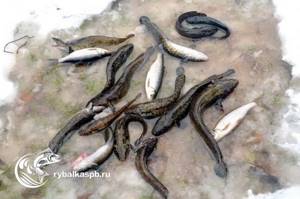
Any fish waste is used as bait. You can chop a couple of fish and throw them to the intended fishing spot. Burbot is partial to raw beef liver. It can be ground in a meat grinder and frozen. The frozen liver is then used as bait. While it melts in the water, the bait will “work”.
They feed the burbot with blood. Any blood that can be bought on the market will do. It is mixed with clay in a one to one ratio. Feeders are filled with bait or thrown into the water in the form of balls.
Features of catching burbot
First of all, it is worth understanding that burbot usually spawns in late autumn - early winter and prefers cold water of 12 degrees and below. Its second feature is that this predator prefers to be nocturnal and lives at the very bottom. Based on this, prepare for fishing carefully and taking into account the fact that you will have to spend a certain period of time, from several hours to days, outdoors in the cold season in almost darkness. Fishing for burbot in the autumn can be a serious test for an unprepared person.
Where to look for burbot in a reservoir, habitats
Finding burbot sites is not easy. It's always a search. He lives in pits and pools. It feeds at the exits of pits. In principle, this is an edge, only not on the riverbed, but on a hole. Such places come across the bends of rivers. Under the steep bank there will be a hole, and under the gentle bank there will be a sandy or rocky spit.
At night, burbot comes close to the shore. Therefore, it makes sense to fish with several gears. The first is thrown into the pool itself, the second to the edge of the pit, the third closer to the shore. As the fish come out to feed at night, all three gears will work. If a stream flows into a pond or river, then this place cannot be ignored. Streams carry with them a lot of food and oxygen. There are always small fish hanging around here. In the evening, burbot will definitely come here, so such places are very promising.

